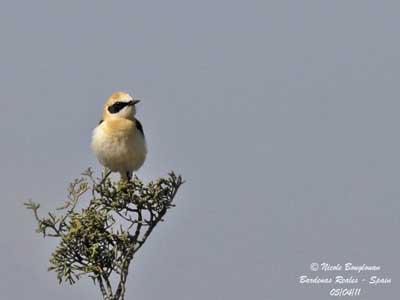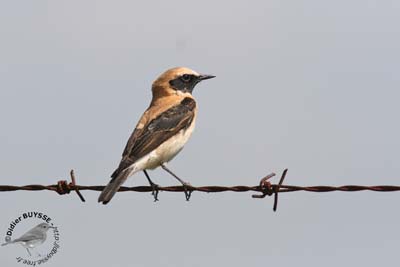
Fr: Traquet oreillard
All : Mittelmeerschmätzer
Esp: Collalba Rubia
Ital: Monachella
Nd: Blonde Tapuit
Sd: Medelhavsstenskvätta
Photographers:
Aurélien Audevard
OUESSANT DIGISCOPING
José Luis Beamonte
Pájaros de España
Didier Buysse
Vision d’Oiseaux
Nicole Bouglouan
PHOTOGRAPHIC RAMBLE
Text by Nicole Bouglouan
Sources:
HANDBOOK OF THE BIRDS OF THE WORLD Vol 10 by Josep del Hoyo-Andrew Elliott-David Christie - Lynx Edicions - ISBN: 8487334725
ENCYCLOPEDIE DES OISEAUX DE FRANCE ET D’EUROPE – de Peter Hayman et Rob Hume - Flammarion – ISBN : 2082009920
BIRDS OF THE MIDDLE EAST by R.F. Porter, S. Christensen, P Schiermacker-Ansen C.Helm - ISBN: 0713670169
THE HANDBOOK OF BIRD IDENTIFICATION FOR EUROPE AND THE WESTERN PALEARCTIC by Mark Beaman, Steve Madge - C.Helm - ISBN: 0713639601
BirdLife International (BirdLife International)
Pájaros de España (JL Beamonte)
Wikipedia, the free encyclopaedia
Black-eared Wheatear
Oenanthe hispanica
Passeriforme Order – Muscicapidae Family
BIOMETRICS:
Length: 13-15 cm
Weight: 12-21 g
DESCRIPTION:
Formerly, the Black-eared Wheatear belonged to the Family Turdidae.
Today, these birds are classified in the Family Muscicapidae with other Old World species.
The Black-eared Wheatear male in breeding plumage shows great contrast between the black wings, face and tail and the ochred-white body which appears very white when seen from some distance.
Males can show two morphs, one with black throat and the other with white throat. The male has pinkish or yellowish-beige head and back. Cheeks, wings and reversed-T of the tail are black, forming strong contrast.
The birds with black throat have black face starting at eye's level.

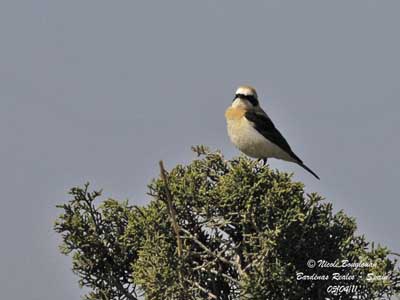
The underparts are white, slightly tinged yellowish-beige, darker on the breast and whiter on the belly. The outer rectrices and the rump are white and conspicuous in flight. The central pair of tail feathers is black. When the tail is broadly spread, we can see a black curve at tip.
The birds which have white throat have it really whitish and we can see a kind of black mask through the eyes extending to the rear of the head.
Both morphs have black bill, legs and feet, and dark brown eyes.
In worn plumage, the bird appears black and white.
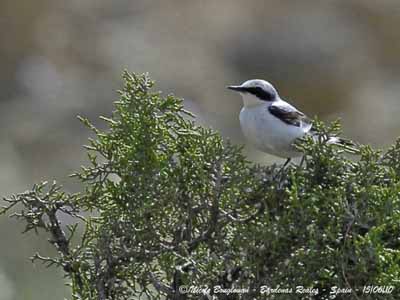
Females of both morphs have sand-coloured head and back, and brown or dark brown wings. The tail shows the same pattern that in male, but the central rectrices and the edges of the others are brown, darker than on the wings, but not black.
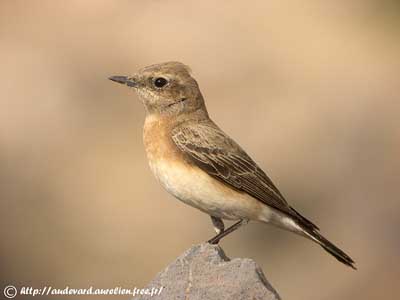
The juvenile has pale beige mottled brown upperparts. On the sides of the face, we can see a darker patch on the ear-tufts. The throat is white or pale beige, and the breast is darker. Tail and wings are similar to those of the adult female, but with some fine white spots.
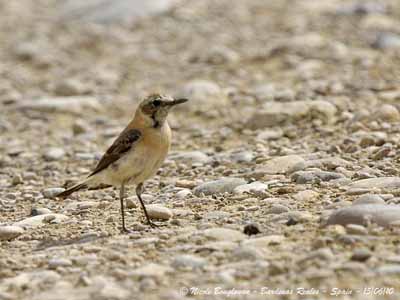
We can find two subspecies which have both morphs:
O.h. hispanica is found in SW and SC Europe and NW Africa. It winters in W African Sahel.
O.h. melanoleuca is found in SC and SE Europe, Asia Minor to Caspian Sea, SW Kazakhstan, and N, W and S Iran. It winters in E African Sahel and NE Africa.
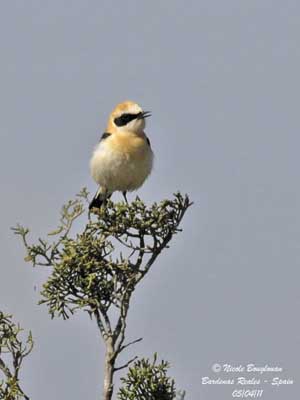
VOICE: SOUNDS BY XENO-CANTO
The Black-eared Wheatear has long-sustained pleasant song, heard from some distance due to the harsh notes. The hard and raucous notes are interspersed, giving the song beauty and variety.
The alarm call and the contact are short and harsh, followed by sad whistle. This bird sings during the flight displays.
It sings from high perches, always in isolated place, far from dark and wet areas.
HABITAT:
The Black-eared Wheatear frequents the opens rocky, arid areas. We can find it up to 2000 metres of elevation, but usually at about 600 metres. It likes the ruins of old castles and the stone walls.
RANGE:
The Black-eared Wheatear breeds in NW Africa, Spain and SE France, Italy, Balkans, Asia and Middle East.
BEHAVIOUR:
The Black-eared Wheatear is often seen perched on shrubs, tree branches and high places rather than on the ground. It feeds by catching insects on the ground from a perch, or also on the wing, and its diet varies according to the presence of insects in the area.
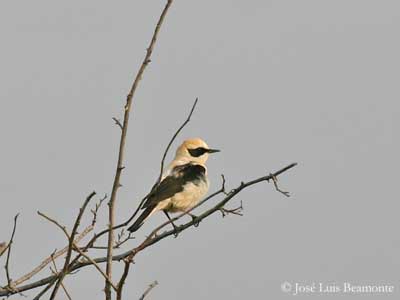
The males perform flights displays while singing. The aerial courtship displays include steep and sudden dives accompanied by songs. These dives are used to spread the tail feathers and to display the black and white pattern.
The territory is established by the male. After the pair-formation, it defends the nest-site while the female builds the nest and incubates the eggs.
This species is migratory. It starts to travel towards the winter areas in late August. The latest birds leave the breeding grounds in October. This species winters in semi-desert areas.
FLIGHT:
The Black-eared Wheatear performs graceful flights during the breeding season.

REPRODUCTION:
The breeding season varies according to the range.
The Black-eared Wheatear’s nest is often placed on the ground, in holes, or sheltered under a rock. It can use a plant as shelter. The nest is bulky. It is made with dry grass and rootlets, sometimes brooms if available. The interior is lined with fine grasses and horse-hair, rarely with wool or feathers, and very little moss.
A tunnel of some centimetres leads to the nest-chamber. Some twigs cover the floor of this tunnel, and can be sometimes placed outside the nest, at the entrance or around it.
But the nest can also be built in old burrow or hole in stone wall.
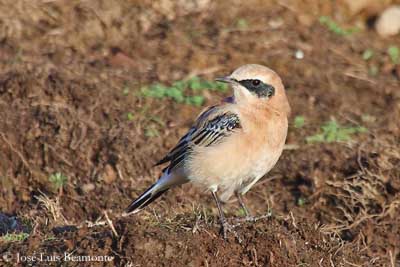
The laying starts in early May and a second clutch can occur in June-July. The female lays 4-5 pale blue eggs, sometimes tinged greenish and speckled reddish-brown. The incubation lasts about 14 days, mainly by the female, but sometimes the male may replace her during short moment.
The chicks are covered in brownish, fairly long down. The young are reared by both parents and fledge about 11-14 days after hatching. They still depend on parents for 9-12 days more.
The second clutch can be laid during this period.
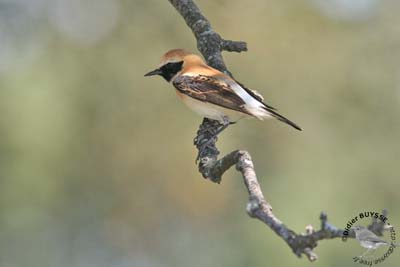
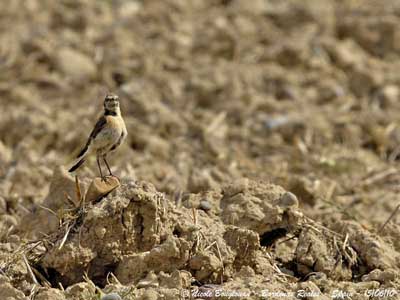
DIET:
The Black-eared Wheatear feeds mainly on insects and spiders. It also consumes some molluscs, grasshoppers and all types of insects, and berries and seeds.
It hunts from a perch and swoops down onto the prey, or catches insects on the wing.
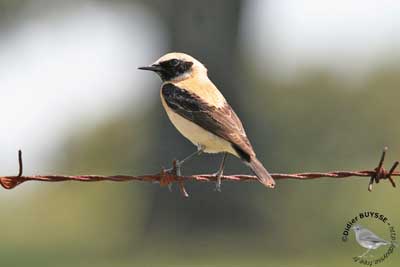
PROTECTION / THREATS / STATUS:
The Black-eared Wheatear is common and even relatively abundant according to the region. However, the species declined in W Europe, and especially in Spain. The droughts and the agriculture expansion in winter areas, and the changes in the habitat are probably responsible of these declines. The species is not currently threatened in spite of these problems.
